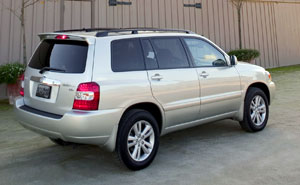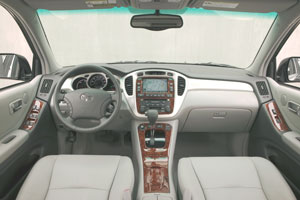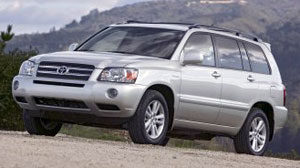2006 Toyota Highlander HybridProgram #2436
What happens when the entire family gets the itch to drive green? Do they face an environmental divide, a Prius for Mom and an Escape for dad? Well, not anymore. Toyota wants to keep the entire family together, and they’re doing that with the first-ever seven-passenger eco-sport-utility, the Highlander Hybrid. Convenient, yes, but will this jolly green giant bridge the gap between practical and purity?
If it can deliver on Toyota’s promise of true SUV flexibility and high fuel economy, then the 2006 Highlander Hybrid is the perfect family vehicle for the 21st century. Like the Prius, the Highlander uses Toyota’s Hybrid Synergy Drive concept that mates a gasoline engine to high-torque electric motors and a continuously variable automatic transmission.
The Highlander shares its second generation powertrain with the Lexus RX400h that we tested earlier, with one exception. While the Lexus is all-wheel drive only, the Highlander is available in front and all-wheel drive.
 Front drive mates a 208-horsepower 3.3-liter V6 with two electric motor-generators, one for charging and one for power, and a 288-volt nickel metal hydride battery pack. All-wheel drive adds a third motor-generator for rear wheel traction.
Front drive mates a 208-horsepower 3.3-liter V6 with two electric motor-generators, one for charging and one for power, and a 288-volt nickel metal hydride battery pack. All-wheel drive adds a third motor-generator for rear wheel traction.
Total power output for all-wheel drive is 268 horsepower and 212 pound-feet of torque. That’s 38 horses more than a gasoline V6 Highlander, but 30 pound-feet less torque.
But despite less torque, the Highlander Hybrid has the same 3,500 pound towing capacity as its gasoline sibling. But the Highlander Hybrid is less about towing and more about superior fuel economy.
In 2-wheel-drive form, the Highlander Hybrid is rated at 33 highway/28 city. With 4-wheel-drive, the rating is 31 highway/27 city. 300 miles of our mixed driving returned an average of 26 miles-per-gallon, or about a 30% gain over the standard Highlander.
The Highlander is a full hybrid. It can run on electric power alone, gas power alone, or any combination. As in its Lexus counterpart, the hybrid system is almost seamless in operation, shifting smoothly between gas and electric as the system’s computer dictates.
And it’s quick, too. Our all-wheel drive tester hit 60 in only 7-seconds flat, over 2 1/2-seconds quicker than our last gasoline Highlander. The quarter mile takes 15.4 seconds, at 93 miles-per-hour.
The Highlander always starts using four-wheel electric power only. So, it doesn’t quite jump off the line like the regular V6. The only vibration is a slight high rpm buzzing from the gas engine.
The electric motors’ contribution is also very apparent accelerating out of corners, or when passing, when they deliver an extra kick of instant torque. With almost 400 pounds extra weight, we expected the Hybrid Highlander to be less agile than the standard model. But again as we found with the smaller Lexus, its well tuned MacPherson strut suspension and standard electronic stability systems allowed it to handle corners like a mid-size passenger sedan.
There is the expected front-end push, but balance is quite good. The electric rack-and-pinion steering is very responsive, delivering quick direction changes, but it lacks feel. The soft springs do produce a fair amount of body roll, but it doesn’t seem to affect the chassis’ composure.
The extra weight does show itself under braking, with stops from 60 averaging a longish 135 feet. Overall stability is quite good, but there’s a distinct lack of pedal feel, and plenty of nose dive.
The Highlander is the first 7-passenger hybrid. But sitting still, other than a few badges, there’s little to distinguish it from other Highlanders.
 Inside our Highlander Limited we also found few changes. There are hybrid system function readouts in the gauge cluster, and if you order the optional DVD navigation system, more information in the large center LCD color display screen.
Inside our Highlander Limited we also found few changes. There are hybrid system function readouts in the gauge cluster, and if you order the optional DVD navigation system, more information in the large center LCD color display screen.
Limited trim also means full leather upholstery on the plush seats. But all Highlander Hybrids get standard side impact airbags for the driver and front passenger, plus side curtain airbags for the first and second row.
Storing the battery pack under the split-folding second row seat costs an inch of headroom, but there’s still enough for 6-footers. The standard folding third row seat, however, is another matter. Entry is tight for anyone over 5-feet tall. So at least two of the seven passengers need to be kiddie size.
As for cargo space, it’s 10.5 cubic feet with all the seats up, 39.7 cubic-feet with the third seat folded, and 80.6 cubic-feet with both second and third rows down. That’s identical to the gasoline Highlander, so you lose nothing in utility, but gain economy and performance.
Of course, you pay more up front. Base price for the 2-wheel-drive Highlander Hybrid is $33,595. Add all-wheel-drive, and the tag reads $34,995. Opt for the more opulent Limited in 2-wheel-drive, and you’ll pay $38,455. While a hefty $39,855 will buy you the top-of-the-line Limited all-wheel-drive. That’s about $5,400 more than a comparably equipped Highlander V6, but nearly 10 grand less than a Lexus RX400h.
While some will want to think long and hard about spending all that cash up front to save gas, we think many others will rush to their Toyota store ready to sign on the dotted line. The 2006 Toyota Highlander Hybrid is a big green machine that bridges the gap between practical and purity better than anything else yet on the 21st Century American road.
Specifications
- Engine: 3.3-Liter V6
- Horsepower: 268
- Torque: 212 Lb Feet
- 0-60 MPH: 7.0 Seconds
- 1/4 Mile: 15.4 Seconds @ 93 MPH
- 60-0 MPH: 135 Feet
- EPA Mileage: 31 MPG City 27 MPG Highway






